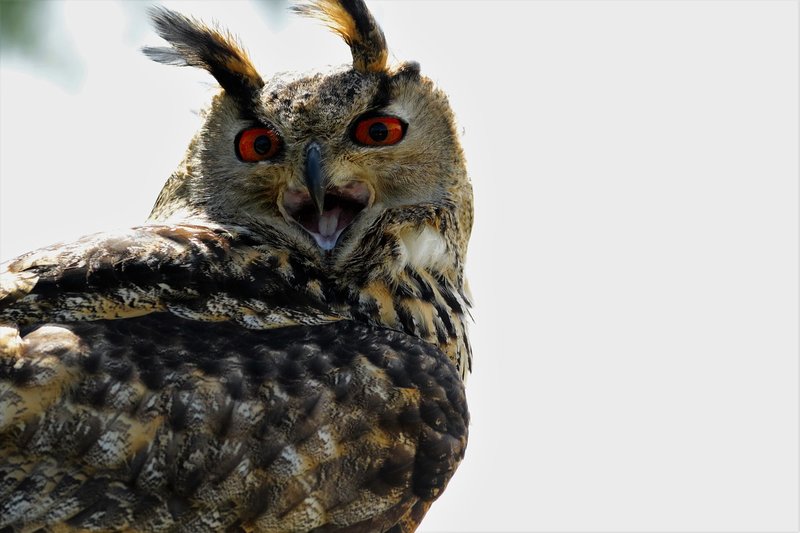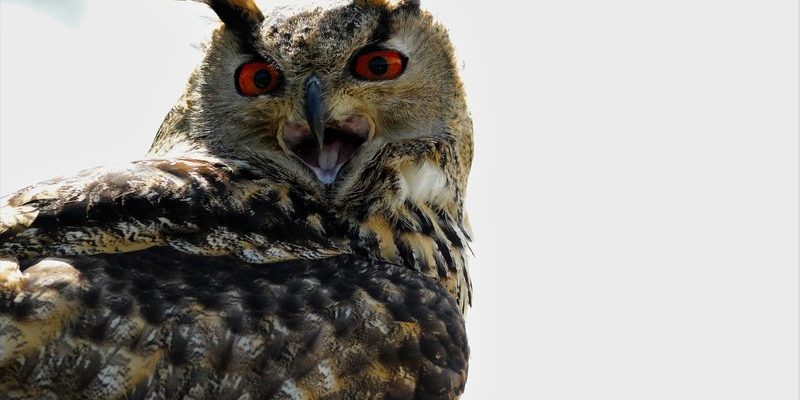
The Eurasian Eagle Owl is a bird that commands attention, akin to a regal monarch perched high on a throne. With its striking features and formidable presence, this magnificent bird is one of the largest owls in the world and has captured the imaginations of bird lovers and nature enthusiasts alike. Imagine a bird that combines strength and grace, boasting feathers that help it blend seamlessly into rocky cliffs and dense forests. That’s the Eurasian Eagle Owl for you!
You might be wondering what makes this owl so special. Well, for starters, its large size and captivating orange eyes are enough to leave anyone in awe. But there’s more! These owls are skilled hunters, equipped with excellent hearing and vision that allow them to hunt effectively at night, which explains their nocturnal nature. In this article, we’ll explore everything from its habitat and diet to how it raises its young.
Physical Characteristics
The Eurasian Eagle Owl is a true giant among owls. Adults can weigh between 1.5 to 4.2 kilograms (3.3 to 9.3 pounds) and have a wingspan that ranges from 160 to 190 centimeters (63 to 75 inches). Their plumage is usually a mix of brown, gray, and orange, providing perfect camouflage in their natural surroundings. With distinctive ear tufts that can stand upright when the owl is agitated, these birds are not just beautiful; they’re also incredibly well-adapted to their environment.
One of the most striking features of this owl is its large, orange-yellow eyes. You may think of these eyes as the perfect spotlight for hunting in the dark. They help the Eurasian Eagle Owl see in low-light conditions, making it a formidable predator. Additionally, they possess a facial disc that helps funnel sounds to their ears, enhancing their hearing ability. When you spot one, it often remains still, allowing it to blend into its surroundings while keeping an eye out for potential prey.
Habitat
The Eurasian Eagle Owl thrives in a variety of habitats, including forests, mountains, and even urban areas. They prefer rocky terrains where they can find suitable nesting sites. You might find them perched on cliff edges or in tree hollows, displaying their majestic profile against the skyline. Their adaptability means they can live in a range of environments, from the cold, snowy regions of Scandinavia to the warmer areas of southern Europe and parts of Asia.
Interestingly, these owls are also known to make use of human structures for nesting. Barns, ruins, and even old factories can serve as perfect spots. This behavior demonstrates their cleverness and willingness to adapt to changing environments. Imagine discovering a magnificent owl nesting near your home—it’s a reminder of the incredible wildlife that can coexist with us!
Diet and Hunting
The diet of the Eurasian Eagle Owl is as impressive as its size. These birds are opportunistic feeders, meaning they will eat whatever is available. Typically, their diet consists of small mammals like rabbits, hares, and rodents. However, they are also known to take down larger prey, such as foxes or birds of medium size, showcasing their strength and versatility as hunters. Picture this: a powerful owl swooping down silently to catch its dinner, using its strong talons to grip tightly.
Hunting at night, the Eurasian Eagle Owl relies heavily on its exceptional hearing and eyesight. They can detect the faintest sounds of movement, which is crucial for locating prey in the dark. Once they identify their target, they can swoop down with incredible speed and accuracy. Their feathers are specially designed to muffle their flight, allowing them to approach without being detected. This stealthy approach is key to their hunting success and survival.
Behavior and Social Structure
Eurasian Eagle Owls are generally solitary creatures, though they do form pairs during the breeding season. When courting, males perform elaborate displays, showcasing their impressive wingspan and hooting calls to attract females. Their vocalizations are unique and can resonate for miles. If you ever hear a deep, booming hoot echoing through the night, there’s a good chance it’s a Eurasian Eagle Owl claiming its territory.
Once paired, these owls are fiercely loyal. They work together to defend their nesting territory and raise their young. During the breeding season, the female lays between 1 to 4 eggs, which she incubates for about 30 days. The male plays a crucial role during this time, bringing food to the female and later to the chicks once they hatch. This partnership is both nurturing and protective, demonstrating strong family ties that are essential for the survival of their young.
Reproduction and Lifespan
The breeding process of the Eurasian Eagle Owl is quite fascinating. After a successful courtship, the female chooses a nesting site, often in a secluded area that offers safety from predators. Once the eggs are laid, she becomes very protective, refusing to leave the nest for long periods. The eggs hatch after a month, and the chicks are born covered in down feathers. In their early days, they depend entirely on their parents for food and warmth.
As the chicks grow, they begin to explore their surroundings under the watchful eye of their parents. They fledge around 6 to 7 weeks old, but independence comes gradually. This is when the parents continue to provide support, teaching them essential hunting skills and how to survive on their own. In the wild, the lifespan of a Eurasian Eagle Owl can reach up to 20 years, while those in captivity may live even longer due to a safer environment and regular food supply. Isn’t it heartwarming to know that these magnificent creatures can have such long lives?
Conservation Status
The conservation status of the Eurasian Eagle Owl is currently listed as “Least Concern,” thanks to their wide distribution and adaptability. However, like many species, they face threats from habitat destruction, poaching, and climate change. Conservation efforts are essential to ensure these majestic creatures continue to thrive in the wild. People are becoming more aware of their role in protecting wildlife, whether through habitat preservation or educating others about the importance of biodiversity.
Various organizations work tirelessly to monitor populations and promote conservation efforts. By participating in local wildlife programs or learning more about owl behavior, you can contribute to their protection. Supporting conservation initiatives ensures that future generations will also have the chance to marvel at the beauty of the Eurasian Eagle Owl in its natural habitat. It’s truly a team effort to safeguard these stunning beings.
Interesting Facts
| Scientific Name: | Bubo bubo |
| Weight: | 1.5 to 4.2 kg (3.3 to 9.3 lbs) |
| Wingspan: | 160 to 190 cm (63 to 75 in) |
| Habitat: | Forests, mountains, rocky areas |
| Diet: | Small mammals, birds, reptiles |
| Lifespan: | Up to 20 years in the wild |
FAQ
Where can I find the Eurasian Eagle Owl?
The Eurasian Eagle Owl is widely distributed across Europe, Asia, and parts of North Africa. You can typically find them in forests, mountains, and even urban areas where suitable nesting sites are available. They prefer regions with rocky cliffs or dense tree cover, making them well-adapted to a variety of environments.
What do Eurasian Eagle Owls eat?
Eurasian Eagle Owls are opportunistic feeders. Their diet mainly consists of small mammals such as rabbits, hares, and rodents. However, they are also known to hunt larger animals, including foxes and birds of medium size. Their hunting skills are remarkable, allowing them to adapt their diet based on availability.
How do Eurasian Eagle Owls hunt?
These owls primarily hunt at night, using their excellent vision and hearing to locate prey. They can detect even the slightest movements, which is crucial in low-light conditions. Once they spot their target, they use their powerful talons and silent flight to swoop down. Their feathers are specially adapted to muffle sound, making them stealthy hunters.
Are Eurasian Eagle Owls solitary or social?
Eurasian Eagle Owls are generally solitary creatures. They tend to hunt and live alone, but they do pair up during the breeding season. Males and females form monogamous pairs, working together to raise their young and defend their territory. This partnership is essential for raising successful offspring.
What is the breeding process like for Eurasian Eagle Owls?
The breeding process begins with courtship displays by males. Once a pair is formed, the female selects a nesting site, often in secluded areas. She lays 1 to 4 eggs, which she incubates for about 30 days. After hatching, the chicks are dependent on their parents for food and care until they are more independent.
How long do Eurasian Eagle Owls live?
In the wild, Eurasian Eagle Owls can live up to about 20 years, while those in captivity may live even longer. Factors such as habitat, food availability, and threats from predators can influence their lifespan in the wild. Proper care in captivity can lead to extended lifespans.
Are Eurasian Eagle Owls endangered?
The conservation status of the Eurasian Eagle Owl is currently classified as “Least Concern,” indicating that they are not facing an immediate threat. However, like many species, they are vulnerable to habitat loss, poaching, and climate change. Conservation efforts are crucial to safeguard their populations for the future.
Can Eurasian Eagle Owls adapt to urban environments?
Yes, Eurasian Eagle Owls have shown remarkable adaptability to urban environments. They can nest in buildings, old factories, and other man-made structures, which provides them with additional nesting options. This adaptability is a testament to their resilience and ability to thrive in changing landscapes.
What is their vocalization like?
Eurasian Eagle Owls have a distinct and powerful hoot that can echo through forests and fields. Their vocalizations are used for communication, especially during the breeding season. The deep, resonating calls are an essential part of establishing territory and attracting mates.
Where can I learn more about the Eurasian Eagle Owl?
You can learn more about the Eurasian Eagle Owl through nature documentaries, birdwatching societies, and various wildlife conservation programs. Many organizations offer resources on owl behavior, habitats, and conservation efforts. Engaging with local wildlife groups can also provide valuable insights into observing and protecting these magnificent creatures.

